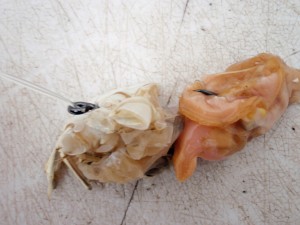Chub Time
Ken Neill
Published in the Chesapeake Angler
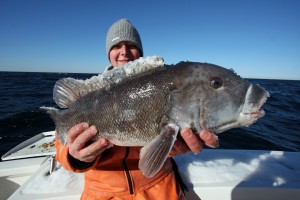 They are called blackfish up north. Tautog is the most universal name. I think that the moniker that fits them the best is chub. Chub is what the Chesapeake Bay old-timers call them and there are several semi-secret locations in the bay, each referred to as “Chub Rock”. Whatever you choose to call these funny looking members of the wrasse family, they are a lot of fun to catch and they are very good to eat.
They are called blackfish up north. Tautog is the most universal name. I think that the moniker that fits them the best is chub. Chub is what the Chesapeake Bay old-timers call them and there are several semi-secret locations in the bay, each referred to as “Chub Rock”. Whatever you choose to call these funny looking members of the wrasse family, they are a lot of fun to catch and they are very good to eat.
 Tautog will be found around structure. Actually, they will be found inside structure. They have a thick skin and an extra heavy slime layer that allows them to squeeze into any nook and cranny that they can find. Shipwrecks, rock piles, rubble around bridges, and man-made reefs are all excellent locations to find tautog.
Tautog will be found around structure. Actually, they will be found inside structure. They have a thick skin and an extra heavy slime layer that allows them to squeeze into any nook and cranny that they can find. Shipwrecks, rock piles, rubble around bridges, and man-made reefs are all excellent locations to find tautog.
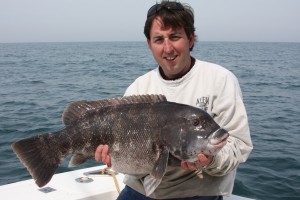 Prominent, strong, conical shaped teeth and thick rubbery lips are well suited to the tog’s diet of crustaceans and mollusks. Those teeth punch through shells and their tough lips handle sharp edges and crab claws. A wide variety of mollusks and crustaceans can be use to catch chub. Any kind of crab can be used. Locally, the favorite is the blue
Prominent, strong, conical shaped teeth and thick rubbery lips are well suited to the tog’s diet of crustaceans and mollusks. Those teeth punch through shells and their tough lips handle sharp edges and crab claws. A wide variety of mollusks and crustaceans can be use to catch chub. Any kind of crab can be used. Locally, the favorite is the blue
crab. Fiddler crabs are an excellent bait, especially in the bay. Hermit crabs, mole crabs, mud crabs…you get the idea, any kind of crab.
Green crabs are a favorite to our north  and have long been brought down to our area as a “secret” bait for tog sharpies. Recently, concern has been raised about using the green crab because it is an invasive species. Unlike the more recent invaders, the green crab was established on the east coast by 1817. For some reason, they are not found in the Chesapeake Bay even though there has been ample opportunity for them to be established. One theory is that they just cannot compete with the native blue crab.
and have long been brought down to our area as a “secret” bait for tog sharpies. Recently, concern has been raised about using the green crab because it is an invasive species. Unlike the more recent invaders, the green crab was established on the east coast by 1817. For some reason, they are not found in the Chesapeake Bay even though there has been ample opportunity for them to be established. One theory is that they just cannot compete with the native blue crab. 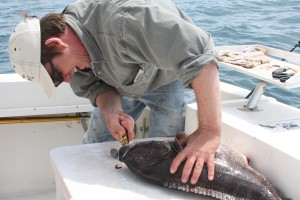 Maybe the blue crab likes to eat the green crab as much as a tautog does.
Maybe the blue crab likes to eat the green crab as much as a tautog does.
Other crustaceans that are less commonly used to catch tautog are shrimp, crayfish, and lobster. Yes, lobster. One of my fishing 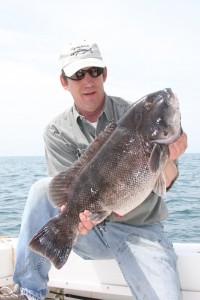 buddies brought lobster and the tautog liked eating eat as much as my family does.
buddies brought lobster and the tautog liked eating eat as much as my family does.
Chub will readily eat most any mollusk. The problem is having bait that is tough enough to stay on the hook. This rules out most mussels, oysters, and some types of clam. Larger hard shell clams (chowder clams) make very good bait. Sea clams make good, tough bait. Conch is very tough 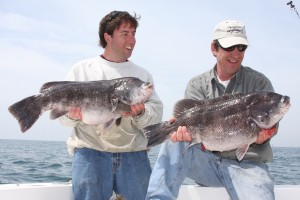 and if you can get it out of the shell, it will be eaten by tautog. Squid is a mollusk but it is not highly thought of as tog bait. I have been on two tog trips where squid (brought by an angler who did not know better) out produced all other baits. Still, I
and if you can get it out of the shell, it will be eaten by tautog. Squid is a mollusk but it is not highly thought of as tog bait. I have been on two tog trips where squid (brought by an angler who did not know better) out produced all other baits. Still, I  do not bring squid when I am targeting tautog. What I do like to bring is a variety of baits. At times, chub seem to pounce on everything. Other times, having the special bait for that day is the ticket.
do not bring squid when I am targeting tautog. What I do like to bring is a variety of baits. At times, chub seem to pounce on everything. Other times, having the special bait for that day is the ticket.
The main trick to catching tautog is to get your bait into where they are living. These fish like to be in the structure and that is where  your bait needs to be. Close is not close enough when it comes to tog fishing. The most common way of achieving this is to use a grappling-type wreck anchor to snag the structure and position your boat directly over it. With tog, just a few feet matter. It you are fishing the structure but are not getting bites, just a little move can make a difference. Let out or pull in a little anchor rope, change the cleat the anchor rope is tied to, turn your steering wheel; a little change
your bait needs to be. Close is not close enough when it comes to tog fishing. The most common way of achieving this is to use a grappling-type wreck anchor to snag the structure and position your boat directly over it. With tog, just a few feet matter. It you are fishing the structure but are not getting bites, just a little move can make a difference. Let out or pull in a little anchor rope, change the cleat the anchor rope is tied to, turn your steering wheel; a little change  can get you into the sweet spot. If just one person on the boat is catching fish, go fish right next to him. A number of togs can squeeze together into a very small spot.
can get you into the sweet spot. If just one person on the boat is catching fish, go fish right next to him. A number of togs can squeeze together into a very small spot.
When the little moves do no work, you have the choice of moving to another structure or staying where you are and waiting them out. Both decisions can be the correct one. There have been many times when I have sat on a wreck most of the day with very little to show for it and then have the bite turn on. Other times, the decision to move to another location has paid off. How many times I will pull 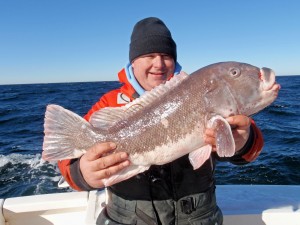 the anchor and move is directly related to how many guys I have on board to pull up the anchor. I am much more likely to stay and wait them out if I am the one pulling up the anchor.
the anchor and move is directly related to how many guys I have on board to pull up the anchor. I am much more likely to stay and wait them out if I am the one pulling up the anchor.
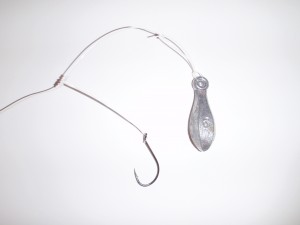 Terminal tackle can be a store-bought bottom rig. Most chub anglers will tie up their own. You will go through a lot of bottom rigs. If you are not getting hung up some, you are not fishing the right spot. Use monofilament of about 50 to 60 pound test to make your rigs. Make a loop at each end, one for your sinker and one to attach to your main line via a snap-swivel. Near the sinker end of the leader, tie a dropper loop for your
Terminal tackle can be a store-bought bottom rig. Most chub anglers will tie up their own. You will go through a lot of bottom rigs. If you are not getting hung up some, you are not fishing the right spot. Use monofilament of about 50 to 60 pound test to make your rigs. Make a loop at each end, one for your sinker and one to attach to your main line via a snap-swivel. Near the sinker end of the leader, tie a dropper loop for your 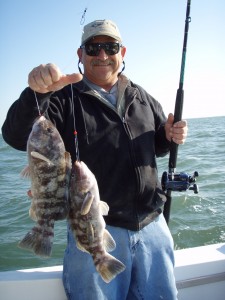 hook. An alternative to the dropper loop is to use a 3-way swivel. Tog rigs typically consist of a single hook. Depending on how snaggy the structure is, I will use one or two hooks. There are times when you will catch tautog two at a time but that is not my reason for preferring a 2-hook rig when I can use it without too many snags. I like the second hook because when I miss that first bite, I have another bait right there. If I have to crank up and re-bait, I may not be able to get back into that same little spot where that chub is.
hook. An alternative to the dropper loop is to use a 3-way swivel. Tog rigs typically consist of a single hook. Depending on how snaggy the structure is, I will use one or two hooks. There are times when you will catch tautog two at a time but that is not my reason for preferring a 2-hook rig when I can use it without too many snags. I like the second hook because when I miss that first bite, I have another bait right there. If I have to crank up and re-bait, I may not be able to get back into that same little spot where that chub is.
 Chub are notorious bait thieves. You will hear that you need to set the hook “before they bite”. This probably was a good statement when everyone was using monofilament fishing line and fiberglass rods. If you thought that you felt something, you set the hook. Graphite rods and more recently, braided line have changed this. When the braids first became popular, I was stubborn. I had been catching tautog just
Chub are notorious bait thieves. You will hear that you need to set the hook “before they bite”. This probably was a good statement when everyone was using monofilament fishing line and fiberglass rods. If you thought that you felt something, you set the hook. Graphite rods and more recently, braided line have changed this. When the braids first became popular, I was stubborn. I had been catching tautog just 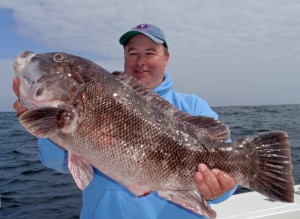 fine and saw no need to change. My fishing buddies switched to braid and they were fun to watch. They were constantly setting the hook on nothing while I was catching tog with my monofilament line. It wasn’t that I was the better angler it was just that I could not feel all of the stuff they were feeling. My bait was down in the structure for the fish to eat while theirs kept yo-yoing up and down. With braid (I made the switch), you can feel everything including that first nibble before the fish gets the hook in its mouth. Don’t set the hook right away, hesitate just a little. You do not want to wait too long however or that chub will take your bait, turn and swim into some cranny that you cannot get it out of. When you do get a hook up, get the fish coming up with authority. You need it several feet away from its hole before it figures out what is going on. Do this and you have him.
fine and saw no need to change. My fishing buddies switched to braid and they were fun to watch. They were constantly setting the hook on nothing while I was catching tog with my monofilament line. It wasn’t that I was the better angler it was just that I could not feel all of the stuff they were feeling. My bait was down in the structure for the fish to eat while theirs kept yo-yoing up and down. With braid (I made the switch), you can feel everything including that first nibble before the fish gets the hook in its mouth. Don’t set the hook right away, hesitate just a little. You do not want to wait too long however or that chub will take your bait, turn and swim into some cranny that you cannot get it out of. When you do get a hook up, get the fish coming up with authority. You need it several feet away from its hole before it figures out what is going on. Do this and you have him.
The prime season to fish for chub is the fall through the spring. Tag returns show that our 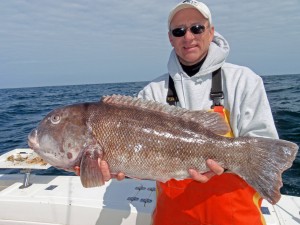 tautog tend to be real homebodies. With few exceptions, recaptured togs are almost always caught where they were originally tagged. Summer is not the best time for tog mainly because of all of the other fish around that will jump on your bait before the tautog. During a mild winter, tautog may stay active in the bay all winter long. When water temps get really cold, tog tend to go semi-dormant and are hard to catch. During the dead of winter, you will need to head to the ocean wrecks to find active fish. If I had to pick the absolute best month to tog fish, it would be April. The water has warmed up and the bite is hot both in the bay and on the ocean wrecks. Get yourself some crabs and clams and go catch yourself a chub.
tautog tend to be real homebodies. With few exceptions, recaptured togs are almost always caught where they were originally tagged. Summer is not the best time for tog mainly because of all of the other fish around that will jump on your bait before the tautog. During a mild winter, tautog may stay active in the bay all winter long. When water temps get really cold, tog tend to go semi-dormant and are hard to catch. During the dead of winter, you will need to head to the ocean wrecks to find active fish. If I had to pick the absolute best month to tog fish, it would be April. The water has warmed up and the bite is hot both in the bay and on the ocean wrecks. Get yourself some crabs and clams and go catch yourself a chub.

